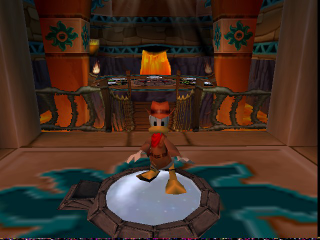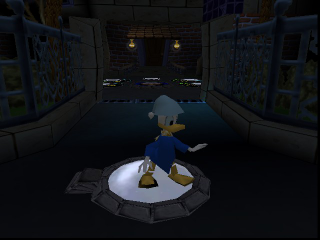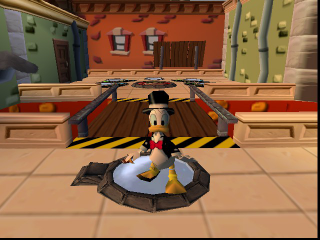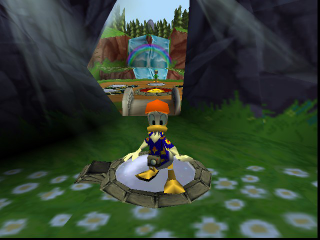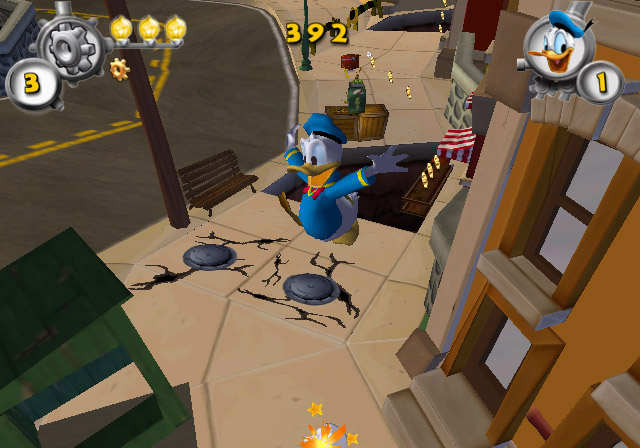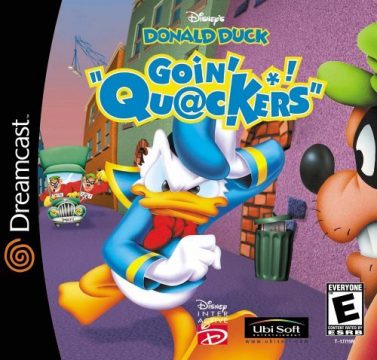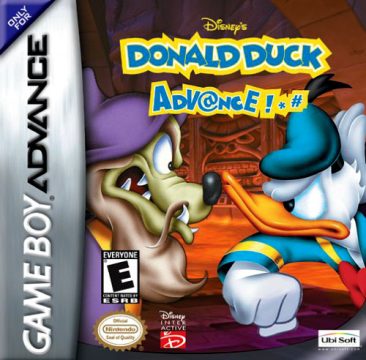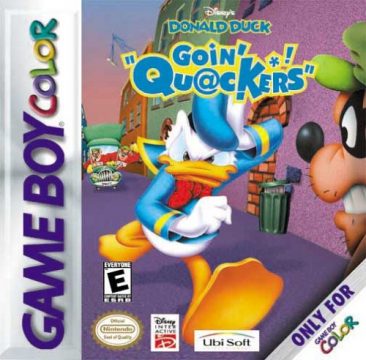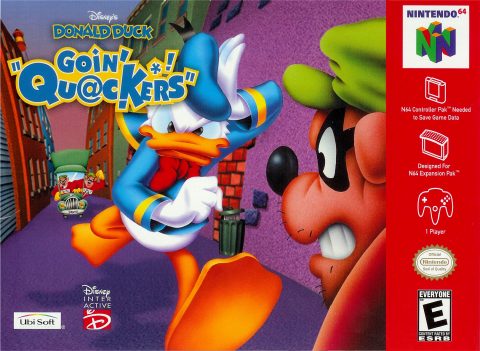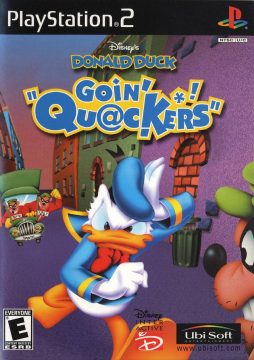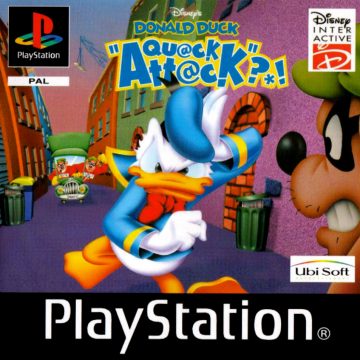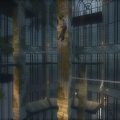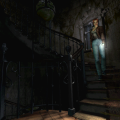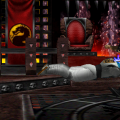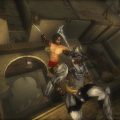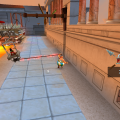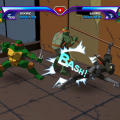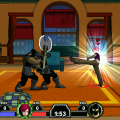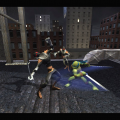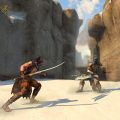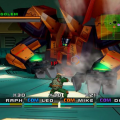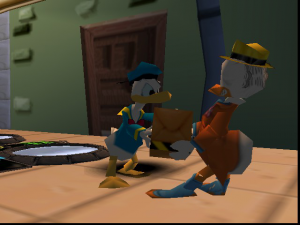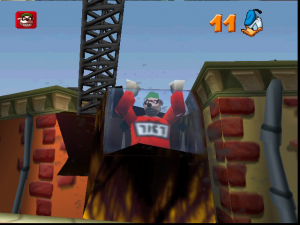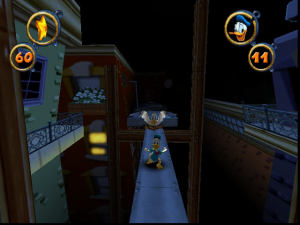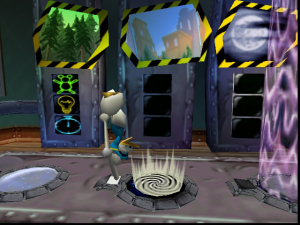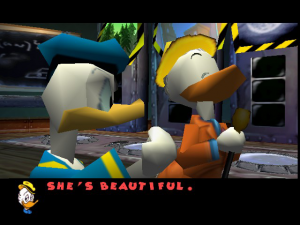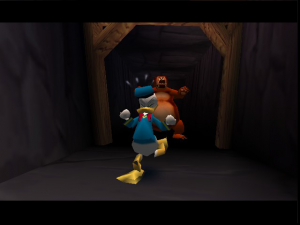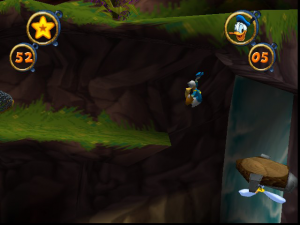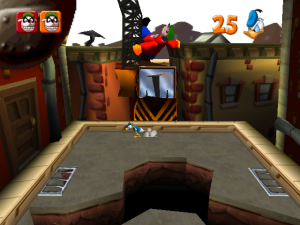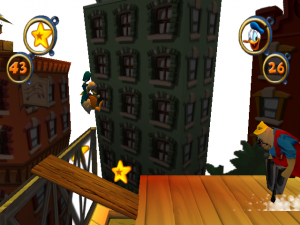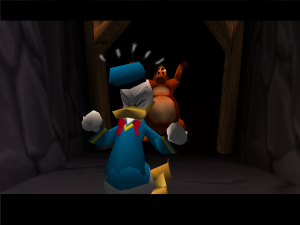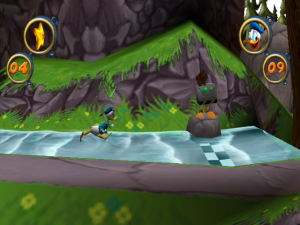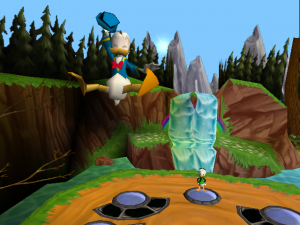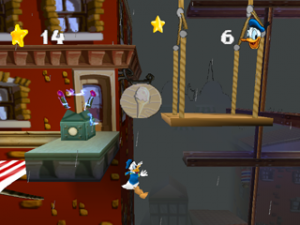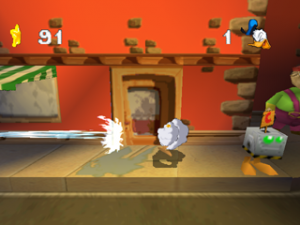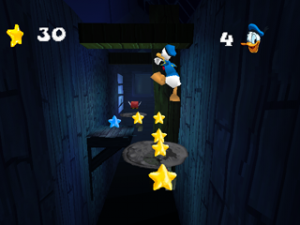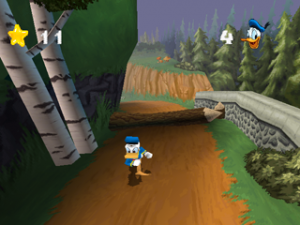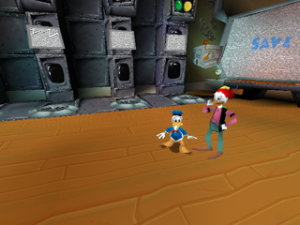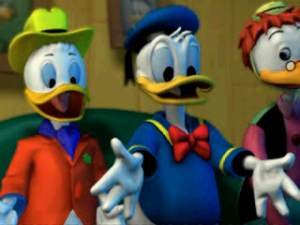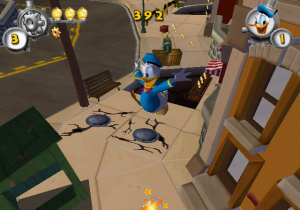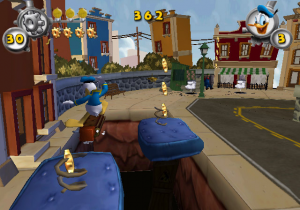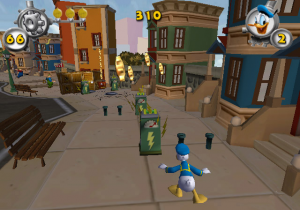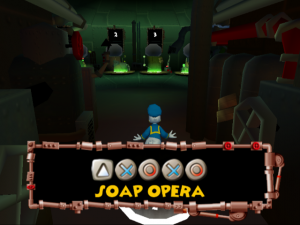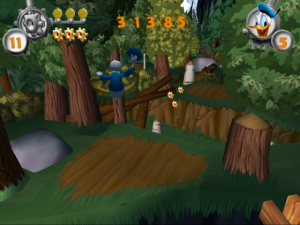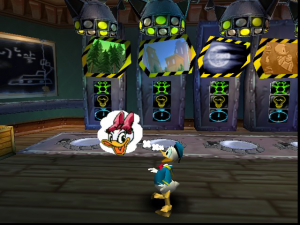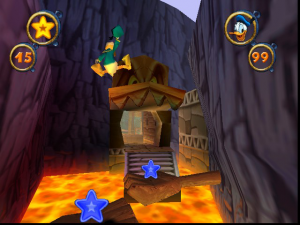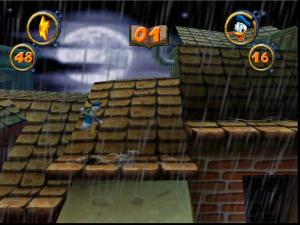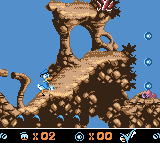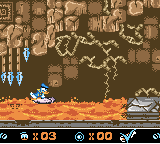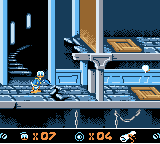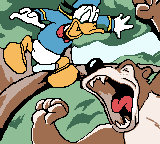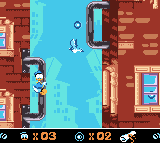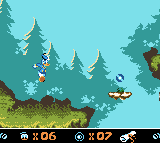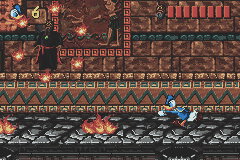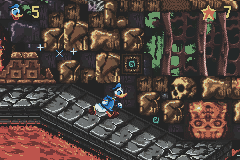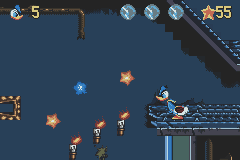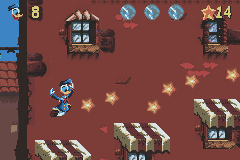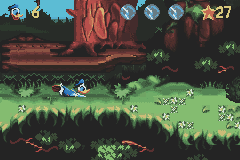- Lucky Dime Caper Starring Donald Duck, The
- Deep Duck Trouble Starring Donald Duck
- Quackshot Starring Donald Duck
- World of Illusion Starring Mickey Mouse and Donald Duck
- Donald Duck no Mahou no Boushi
- Magical Quest 3 Starring Mickey and Donald
- Maui Mallard in Cold Shadow
- Magical Tetris Challenge
- Donald Duck: Goin’ Quackers
By the time the year 2000 rolled around, Disney had lost some faith in Donald’s marketability and popularity. In Europe he was still the king, always front and center on all magazine stands and ever so popular with both young and old, but this was not the case in the US. Donald Duck comics had never reached the levels which they saw in Europe and many of the planned redesigns and updates to his character were either scrapped or flopped completely. Maui Mallard had been victim of this due to Disney’s mismanagement, and when they tried to modernize not only Donald but also his nephews and Daisy in the animated show Quack Pack in 1996, it failed miserably and created a huge fan uproar. The show was cancelled after only 39 episodes, despite having been set into production with 69 episodes. It is regarded as one of the worst Disney productions ever made, further spiraling Donald’s reputation down the drain at Disney HQ. It would seem as if Disney had forgotten why Donald was popular in the first place, a loveable underdog with more human qualities than his Disney brethren.
Donald was mostly used in supporting cast roles in the later part of the 1990s and Donald-exclusive merchandise produced in those years was scant. Disney Interactive and its subsidiary studios also relaxed their output, and began to outsource licenses again in hopes to boost both sale and quality by working with more well established names and companies. In 1999, French developer UbiSoft signed a partnership deal with Disney to start producing games based on both new movies and classic properties. The first game out of this partnership was a brand new Donald Duck game, Donald Duck: Goin’ Qu@ckers. Originally the game was to be called Qu@ck Att@ck, but was changed sometime before release possibly to avoid confusion with the show Donald’s Quack Attack from 1992. The original name was kept in Europe. A total of eight versions of the game exist, with six of them being released in 2000, two in 2002 and one being rumored for future release in 2011. All the initial six versions were based on UbiSoft’s Rayman 2 engine, which allowed for rich, colorful 3D worlds with intuitive camera angles. The N64 version served as the basis for most versions of the game. The game was released shortly after the passing of Carl Barks, and is therefore dedicated to his memory and legacy.
In Goin Qu@ckers, Donald goes back to his roots and is simple, bumbling underdog with a bad temper. Daisy Duck is Duckburg’s most daring news reporter, and this time she has managed to sneak into Merlock The Magician’s temple. She broadcasts live to the people of Duckburg hoping to uncover what Merlock is attempting to do and Donald, Gladstone Gander, and Gyro Gearloose are all watching in suspense as Daisy slowly works her way towards Merlock. It seems the magician isn’t too fond of uninvited visitors however, and decides to capture and kidnap Daisy, all while being filmed and broadcast live. As Donald and Gladstone witnesses the horrible turn of events, they waste no time and head for Gyro’s teleporter to go save her, both competing against each other to win Daisy’s heart and be the hero of the day. Gander gets the head start due to Donald tripping, but it seems luck isn’t with him because Gyro’s teleporter isn’t working properly, and in order for it to send Donald to the temple, he has to travel around the world first and power it up sufficiently. With Gyro’s support and Huey, Dewey and Louie along the way to help him, Donald sets out to save Daisy before Gladstone ever gets the chance.
Though the game mostly keeps Donald as strictly classic as possible, it does take inspiration from numerous sources. In the Quack Pack cartoon, Daisy was a hotshot reporter for the local Duckburg television channel, a role she reprises here, though her design remains in style with the classic bow tie and dress rather than the mini skirt and haircut in Quack Pack. The locations and the designs of buildings and certain environments take heavily from Carl Barks’ illustrations and the tone of the adventure itself is done somewhat similar to the structure of Barks’s stories. Donald himself goes more back to his original cartoon shorts behavior being buffoonish and usually dealt the worst cards, but heroic and daring nonetheless.
Donald has several special abilities in the game. The most handy and often used is the double jump. This allows him to reach tough to reach places, avoid dangers along the ground and even save himself from death if he slips off the edge. To defend himself, Donald also has a barrage of punches and kicks which a strung together in a small combo by pressing the attack button. The combo shares a strong resemblance to the string of offence Mario dished out in Mario 64, though all enemies in Goin’ Qu@ckers only take one hit to kill. Donald also has four distinct “moods”. In his normal mood, his movement, expressions and attacks reflect a rather cheerful and valiant demeanor. Anger mood occurs after being hit once, which then makes Donald have an outwardly grumpy look, with all his movements changing to a much more direct and aggressive behavior. Rage mood is a state of chaotic frenzy which is triggered right after being hit, only showing a cloud of dust and making Donald invincible for five seconds. Hyperactive mood is triggered if Donald drinks a sundae, which gives him double the speed and makes him nearly invincible for 15 seconds, except from some land based hazards like poison ivy. Donald can take two hits before dying, but the sundae will reset any hits taken and also acts as a health refill.
The game consists of four overworlds which contains four standard levels to choose from, making a standard play through 16 levels long. Before accessing them, Donald finds himself in Gyro’s lab, which acts as the main hub of the game, allowing players to save their games and such. The worlds takes place through dour distinctly different terrains, with a forest area, downtown Duckburg, Magica De Spell’s manor and last Merlock’s temple being the ones to choose from. Goin’ Qu@ckers features three different styles of gaming. Each of the four levels on each world is split into two types, 3D and 2D platforming. Two of the levels are 3D where Donald runs inwards the screen jumping over hinders and navigating through an open though narrow 3D space, which hosts a number of secrets and other items for him to find before reaching the end. These stages are extremely similar to the ones found in Crash Bandicoot. The 2D stages are played like the standard platformer, running left to right with the camera being locked on a side view. Both styles feature the same kind of obstacles, making use of the double jump to cross large gaps or land on moving platforms. The 3rd style is the boss battles, which all are unique and requires different strategies from one another. On each level there are stars that can be collected for 1-ups once a 100 is collected.
The objective of all the stages are the same. There are a total of four essential items to be found on each of them. Huey, Dewey and Louie’s toys have gone missing and are scattered around each level. So Donald has to find 3 toys. In order to find them, it is required to find the corresponding flying storybook character and hit it, which then starts a countdown which allows for the toy to be picked up within the short time span given. Failure to do so means the book must be hit one more time to start the timer over again. Each stage also holds a Boss emblem. Once all four of these are found, it opens up the boss stage for that particular area. Once the bosses are beaten, the next world is unlocked and can be accessed from Gyro’s lab. Each stage sans boss stages feature multiple objectives as well. If Donald is able to find all three toys on all four levels, his nephews will allow him to access a 5th level, which is always a chase level. These levels are played by running towards the screen and avoiding oncoming obstacles while still making sure whatever is chasing him doesn’t catch up. Once the chase stages are beaten, Gladstone challenges Donald to race his ghost time on each level, promising a reward if he does so. Beating all the time attacks unlocks new costumes for Donald to wear during the game. These are also accessed in Gyro’s lab.
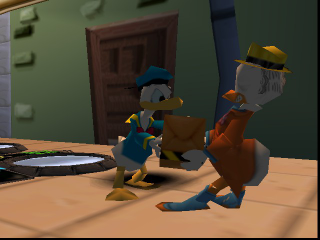
Donald Duck: Goin’ Qu@ckers (N64)
As people had come to expect from a Disney title, the game looks and sounds fantastic, especially for an N64 game. Most of the attention went into making Donald look, move, talk and feel like he should, and takes many cues from his cartoon shorts (the dance of anger, feet skipping like in “Clown of the Jungle”). He moves ever so smoothly and all mannerisms ooze with personality. The best part is the victory dance Donald does once he picks up all items, which is probably the happiest victory dance ever in a video game. The music, composed by Rayman 2‘s Daniel Masson, is a diverse mix of styles fitting each area. The N64 was often under attack for being a weak system when it came to music and sometimes deservedly so, but Masson did a great job picking the right instrumentations and samples to keep it from sounding cheap and as a result it sounds very similar to the CD versions of the game which features live recordings of the songs. The Duckburg tracks stand out with some pretty atmospheric drum & bass tracks, similar to the works of Tekken‘s Keiichi Okabe.
There is very little challenge to be found within the game however, and it never forces players to break a sweat, if even make any real effort. The stage designs are fun and attractive but they never become really challenging, just barely making some of the jumps later on a bit more tricky. They are also a bit of a let down considering how great some of the levels are in Rayman 2, which was released one year prior to this game. Most of the deaths are likely going to be related to the trouble of properly coordinating jumps when running inwards or outwards the screen which at time can be quite annoying. The boss battles are generally the most fun since they are all different from each other and actually come off as a bit challenging, though still easily beaten once the rhythm and strategy is down. Experienced players will race through the game in an afternoon even if they decide to beat every objective on every level, but younger players as well as inexperienced ones will find a lot of fun within the game. Deep down it has everything a good game should have, good design, loveable characters, great sound and most importantly, easy and responsive controls.
The Playstation, N64 and Dreamcast versions of Goin Qu@ckers were all developed side by side and released around the same time, yet there are some differences. The most different out of these is the PlayStation version which features all exclusive level designs and music. Whereas in the N64 versions the stages are split between either 3D or 2D, the PSX version combine them often in the same level. Stages are also completely different from the other versions and are actually a bit more challenging, especially the boss battles, which makes it a more suitable game for even older players. It’s still a very easy game and can be finished in a few hours like its N64 counterpart. While the N64 used the in game engine to render the cut scenes real time, the PSX has longer CGI cut scenes which are far superior, using gags and humor often found in the old cartoon shorts. There are also more sound bytes throughout the game than in the N64 version. The graphics can’t quite compare with the other versions of the game and suffer from more jagged animations and bland backgrounds with flat colors and objects. There are different enemies as well, like banana throwing monkeys in the forest or anthropomorphic skunks. The music is completely different and shockingly good. Though fewer songs in total, the songs are now 7-8 minute grand epics with choirs, unique percussion elements and extremely catchy melodies. This soundtrack was composed by Shawn K. Clement, who is most famous for composing Buffy: The Vampire Slayer. The only issue with this soundtrack is the strength of the music often goes into the forefront of the game and becomes a bit out of context compared to what’s going on in the game itself.
The Dreamcast and PC version are nearly identical to the N64 version though with improved graphics and sound. The framerate is much smoother and the PC version offers the highest resolution and best textures. The soundtrack is Daniel Masson’s version, though now with live instruments and longer track lengths with better looping points. The PC edition also comes with an all exclusive install theme which plays while the game is being installed onto the computer. The only real difference in these versions is that the patterns of the last boss are slightly different from the N64. The Dreamcast and PC version also uses the CGI cut scenes from the PSX. Out of all the home console versions, the Dreamcast is probably the best as it offers the best graphics and sound along with the more interesting cut scenes.
The handheld games differs greatly. The storyline is still Daisy being kidnapped by Merlock, but here Donald finds out through the newspaper and calls Gyro up for assistance. The game is a 2D platformer that follows the structure of the console versions, while using all exclusive stage designs and gimmicks. Huey, Dewey and Louie are nowhere to be found, and Donald is in search of orbs rather than toys, which are found and acquired in the same way as the toys in the console version. Donald can only jump on enemies and no longer has his punches and kicks. The Game Boy Color version features some of the best animations and graphics ever seen on the handheld, but the soundtrack doesn’t live up to the quality of the graphics and is a forgettable score sadly. The Game Boy Advance version builds upon the Game Boy Color version, though gives Donald some new abilities like crawling and his punching returns. It also makes use of the sound samples from the console version much like the Mario and Zelda remakes on GBA, and the soundtrack is small digital loops of the Daniel Masson score, which sounds a bit scratchy. Both the handheld games are quite good, though very short in length.
A few years after its release, the game was once again updated and released on the PlayStation 2 and Nintendo GameCube. This game was built from the ground up using an all new engine, and as a result is more like a sequel than a remake. The levels are a brand new set in the same environments as before, and still alternate between 3D and 2D. The 3D stages makes use of a new dynamic camera system that curves around and zooms in and out, though the levels remain very linear and narrow. Also new to the game is the ability to unlock special moves for Donald. His nephews sport a different role in the game, rather giving Donald special moves if he manages to spell out Special while running through the stage. This is done by picking up five clock wheels in rapid succession enough times to spell the word out. The overworld hub now takes place entirely in Gyro’s redesigned lab. Shawn Clement’s soundtrack is brought back in this version, and is a much better fit with the all new redesigned levels. Donald himself sports plenty of new animations and sound bytes and the overall game looks much more alive than any of the other versions. The chase stages now only feature the floating hand which chases Donald in Magica De Spell’s manor in the original, which is a bit of a letdown since the different chase sequences were quite fun. Overall, the game is very similar, with all the bosses returning mostly doing the same kind of attacks they did before. The game is still insultingly easy like its predecessor.
A rumored 3DS version is in the works, which is most likely based on the fact that Rayman 2 was ported over as a launch title for the system. While the game would be a good fit for the 3D capabilities of the 3DS, it is unknown if UbiSoft still holds the license to release Disney products.
Costumes
